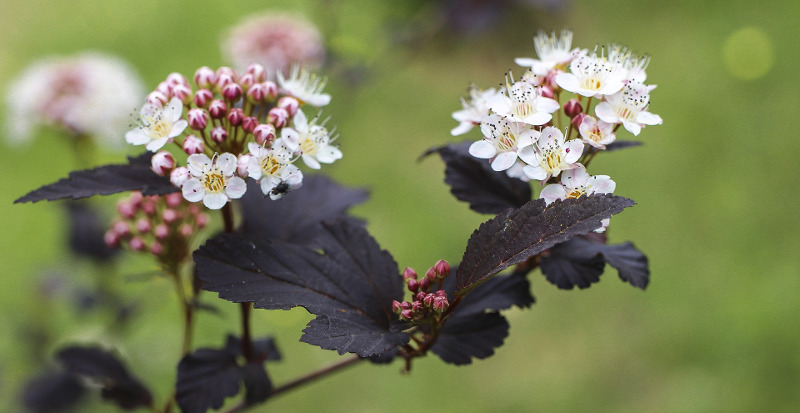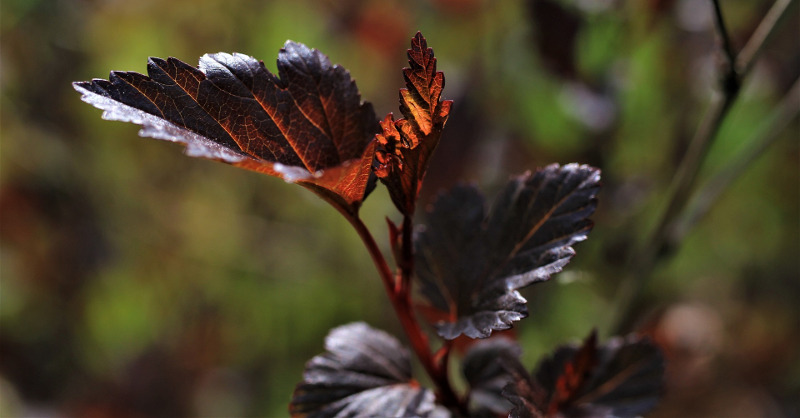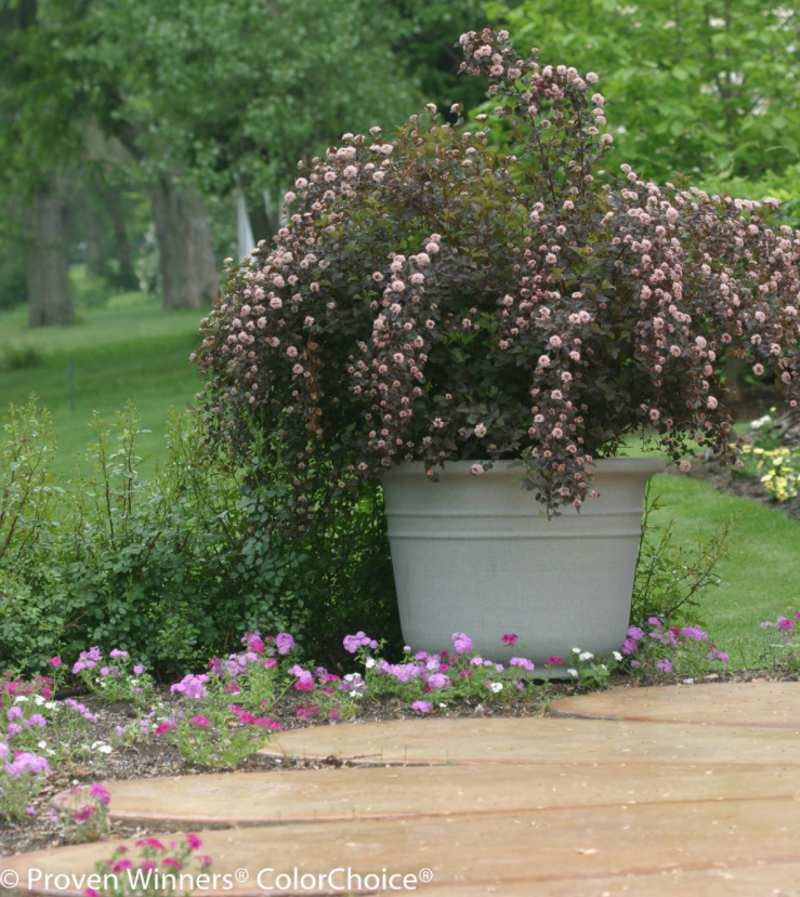Ninebark (Physocarpus) is one of the easiest and carefree plants for the home landscape. Choose a cultivar to fit your needs from ‘Tiny Wine Ninebark’ that grows from 3-5 ft. high and wide to ‘Coppertina’ Ninebark that grows 6-8 ft. wide and high. It is hardy from Zone 2- Zone 7.

Planting Ninebark
It is important to site your plant properly. It requires full sun for optimum growth and blooming since it is a desired pollinator plant too. It is fairly tolerant of most soils and requires regular watering to get the plant established but after that, occasional watering is only required. Good air circulation is always important to prevent any fungal diseases so plant it in an area where it has circulation all around the plant. Also pruning out any crossed branches always helps.
Dig a hole that is twice as wide as the plant in the container or if it is balled and burlapped. Do not dig a hole deeper than it is in the container or burlap. Remove any rocks or other debris in the hole. It is not necessary to add any amendments to the soil.
If the plant is in burlap, remove all of the burlap and any twine that may be holding the burlap around the plant. Loosen the roots no matter if the plant is in burlap or a container. That allows the plant to take root better in the soil. Ninebark should be planted just at the base of the plant and not deeper which will prevent flowering. Water thoroughly after planting and mulch lightly, keeping the mulch away from the base of the plant.
Watering Ninebark & Fertilizing Ninebark
Ninebark is an easily cared for landscape plant once established. It tolerates most soils so occasional watering is all that is required. It is considered a drought tolerant plant although if you are in a drought you should water all your plants thoroughly. When watering your plant be sure to allow the water to soak in slowly so it hydrates the plant completely. Water the plant all the way around the plant, not just in one spot. Depending on the size of the plant at least 1-2 gallons of water is needed to keep it in optimum health and while establishing it in the garden.

Fertilizing ninebark is easy too. Just add a slow release, all-purpose fertilizer in the early spring is all that is required. Just spread it around the base of the plant and water it in to provide season long fertilizer. You don’t want to use a liquid fertilizer because it provides too much nitrogen to the plant all at once.
Ninebark Winter Care
Caring for your Ninebark in the winter is easy. Before the first freeze in your area, be sure to water the plant thoroughly to help protect it from winter winds. You may want to consider wrapping some hardware cloth near the base of the trunk to prevent rabbits and other rodents from nibbling on it during the winter, especially if they are an issue in your area.
In late winter or very early spring, you may want to do some pruning including cutting off any broken or crossed branches. If you wait much later you will cut off the beautiful blooms of the plant. Once the plant gets large, you may want to consider renewal pruning which means cutting off the heaviest of the branches probably at the base of the plant but don’t remove more than 4-5 branches. That will also allow for better airflow through the plant. You should only consider doing renewal pruning every 3-4 years.
Growing Ninebark in Pots
If you are growing Ninebark in pots you should use a large enough pot that provides adequate drainage. The best ninebark to use in pots are ‘Tiny Wine’ ninebark and ‘Tiny Wine Gold’ ninebark since they are the smallest of the ninebarks. The pots should be at least 24 inches wide and filled with a potting mix designed for nursery stock rather than flowers and vegetables.

Depending on your growing zone you may need to consider providing them with winter protection to prevent heaving or having the roots freeze out.
Common Ninebark Questions:
How Big Do Ninebark Shrubs Get?
There are some varieties that stay as small as 3 to 5 feet and others that can get as tall as 8 feet and they vary in width from 3 to 12 feet.
Are Ninebark Native To The United States?
One of the best attributes of growing ninebark in your garden is that the plants are native to the Eastern and Central regions of North America. The plants can be found growing in the wild in several states from the East Coast to states as far west as Minnesota, Iowa, Missouri and Arkansas. Being native to the United States means that the plants can survive easily without human help, making these very low maintenance plants. This also means the plants are very beneficial to local wildlife including bees, butterflies, and birds.
Can Ninebark Tolerate Shade?
Ninebark can tolerate shade, but will do better and flower more profusely the more sun it receives.
Why Is My Ninebark Leaves Turning Yellow?
While some nandina feature yellow leaves, along with purples and reds, yellowing leaves can be caused by several things, over- or underwatering or a nutritional deficiency in the soil, usually iron.
What Is The Growth Rate For Ninebark?
Most ninebark varieties are fast growing, they can often meet their mature size in one growing season.
What Are The Common Ninebark Diseases?
One of the diseases ninebark is most susceptible to is powdery mildew, which is more likely to happen when the air circulation around the plant is poor and the humidity is high.
Are Ninebarks Poisonous?
Ninebarks are not considered poisonous either by the ASPCA or the USDA. Some people who use plants for medicinal purposes report that a tea made from the leaves can act as an emetic or cause diarrhea in humans. If you or a child eat the leaves and become ill, you should contact your local emergency room for more direction. If your pets show a propensity for eating the leaves or the bark of Ninebark, you can use a repellant spray like you would use for deer or use a barrier to prevent the pet from eating the leaves although most animals leave it alone.
Are Ninebarks Deer Resistant?
Ninebark (Physocarpus sp.) plants are deer resistant although they can sometimes be damaged by bucks rubbing branches during the rut season. On a rare occasion a young fawn may nibble at a plant only to be discouraged by its mother who will show them more tasty plants in the landscape.
Ninebark is an excellent plant to use in areas where deer browsing is known to happen or if there are large herds of deer in the vicinity.
It is an ideal plant to use as a windbreak, a backdrop for smaller plants or as a focal point in the garden since it provides wonderful texture and fabulous fall color.
Have a question about Ninebark? Fill out the form below and we will try and get back to your question as soon as possible. We may even feature your question in this article to help other gardeners!
 |
Author Denise Schreiber - Published 1-4-2021 |
